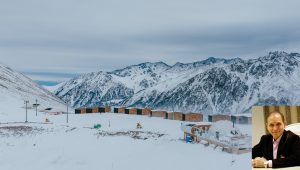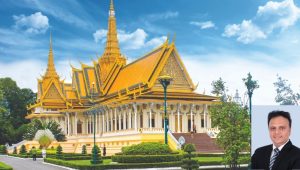Land of Values & Intellect
A Paleolithic culture around 30,000 BC constitutes the first known habitation of the Japanese archipelago. Often called the Land of the Rising Sun, Japan has always shown the world way forward be it technology, showing respect to others, or living in harmony. Today, it is the world’s third-largest economy by nominal GDP and the world’s fourth-largest economy by purchasing power parity. It is also the world’s fourth-largest exporter and fourth-largest importer, and is considered a great power.
By His Excellency Dr. Akima Umezawa, Consul-General to the UAE, Japan
As a vision of Japan, I’d like to introduce a keyword “Society 5.0” which is defined as “A human-centered society that balances economic advancement with the resolution of social problems by a system that highly integrates cyberspace and physical realities”
High Level of Vision
The naming of Society 5.0 implies the 5th generations of the social revolution, following the hunting society (Society 1.0), agricultural society (Society 2.0), industrial society (Society 3.0), and information society (Society 4.0). Society 5.0 is a vision of super smart society, and an ongoing policy principle advocated in the 5th national plan of science and technology, which was adopted at the Cabinet headed by Prime Minister Shinzo Abe in 2016. In the super smart society (Society 5.0), “Internet of Things (IoT)” connects all people and things, and all sorts of knowledge and information are shared, then totally new value will be born. “Artificial Intelligence (AI)” frees humans from burdensome works of analyzing huge amounts of information. The possibilities of humans expand through the evolutionary utilization of robots, autonomous car, etc. Society 5.0 achieves a high degree of convergence between cyberspace (virtual space) and physical reality (real world). A huge amount of information from sensors in physical space is accumulated in cyberspace. This big data has been analyzed by artificial intelligence (AI), then the outcome has been already fed-back to the Japanese society in real world in various forms. This process brings new value to industry and society in super smart ways. As the economy grows globally, there have been growing socioeconomic challenges such as the reduction of greenhouse gas emissions, a stable increase of foods production while a reduction of loss of food-staffs, mitigation of social and economical costs associated with aging society, support of sustainable industrialization, redistribution of wealth, and correction of regional inequality for the prosperous world. New technologies such as IoT, robotics, AI, and big data drive a drastic change in society developments to resolve such challenges. Under the Society 5.0, Japan seeks a new super smart society that incorporates these state-of-the-art new technologies in all industries and social activities, consequently achieving both economic development and solution of socioeconomic challenges in parallel.
Tourism Opportunities
In 2017, inbound visitors to Japan achieved the record high of 28.7 million which shows the number of foreign tourists has increased 20%- 40% annually during the last five years. Tourists’ interests in Japan as a destination have widely expanded through visit-promotion campaigns by not only enhancing the Japan’s rich attractiveness but also the exemption and relaxation of visa requirements, the expansion of tax-free program, expanding the flight and cruise networks, and so on. For example, the government of Japan has taken the visa relaxation measures for the UAE nationals in 2017 and Indian nationals in 2018. Current targets of the number of inbound visitors are 40 million in 2020 and 60 million in 2030, respectively. These targets will be achieved through further strengthening the visit-promotion campaign, especially through maximizing the opportunity of the world-class big events held in Japan, such as Rugby World Cup 2019 and Tokyo Olympic and Paralympic Games 2020. Inbound tourism is one of the most important growth sectors, currently contributing 4.5% of the Japan’s GDP. Marketing and promoting the inbound tourism also utilize the cross-sectoral business activities including digital marketing, social media, and collaboration with local government. Another challenge for the expansion of inbound tourism in Japan would be to diversify the source of market, where tourists coming from North East Asia region account for 85% of total inbound visitors and for 10% from South East Asia in recent years. The statistics shows heavy concentration on the inbound market in the East Asia. In the meantime, the number of visitors from the UAE has increased from 2,027 visitors in 2012 to 7,106 visitors in 2017. Such a longterm steep increase as recorded at 70% annual expansion of the number of visitors from the UAE to Japan demonstrates further potential of hottest market for the tourism sector between the two countries.
Strengthening Strategic Partnership
First, I would like to introduce some of the remarkable developments of the bilateral relations in political and business sectors. A highlight of the political relations was the leaders meeting between H.E. Mr. Shinzo Abe, Prime Minister of Japan and H.H. Sheikh Mohammed bin Zayed Al Nahyan, Crown Prince of Abu Dhabi and Deputy Supreme Commander of the UAE Armed Forces on the occasion of the visit of Prime Minister Shinzo Abe to the UAE in April this year. They formulated the “Joint Statement on Deepening and Strengthening Strategic Partnership between Japan and the United Arab Emirates – Opening a New Chapter of Cooperation towards Prosperity and Stability, as a reflection of their desire to further develop bilateral strategic relations in all areas of cooperation. Through delivering the Joint Statement, both leaders affirmed their commitment to formulating a joint vision and a joint cooperation strategy under the “Comprehensive Strategic Partnership Initiative”. They also confirmed their strategic coordination in the areas of (1) political cooperation, (2) economy (business, trade and investment) including diversification of non-energy sector, including the small and medium enterprises, (3) cultural cooperation – Expo and Olympic, (4) education, advanced science and technology including the space cooperation, (5) cooperation in environment, energy and water, (6) defense cooperation, (7) aviation cooperation, (8) security cooperation, (9) cooperation in the fields of agriculture and food security, (10) women empowerment, and so on, under the commitment of strengthening their strategic partnership in a comprehensive manner. Since I have been posted here in Dubai as the Consul General in Dubai, honestly speaking, every step I have taken is humbly not so big one. I have extended dialogues with every department of the Dubai government as well as many departments of Sharjah and other Emirates’ governments. I have delivered my speeches and presentations at various occasions where I was invited by the above governments, the federal government, private sectors and social clubs, promoting the Japanese culture, state-of-the-art technologies, business practice and so on. I have also coordinated business seminars, inviting respectively the Japanese Ambassador to Iraq, to Lebanon, to Kuwait, to Iran and so on as lecturers. I have promoted Japanese products, technologies, cultures and service to the UAE people and market through many events organized by the Consulate-General. There are many of such small steps I have taken, based on the friendly and cordial relations between the UAE and Japan. More importantly, every member of the Japanese community in Dubai has also contributed to enhance our cordial bilateral relations to a greater or lesser extent. Gathering and accumulating these variety of endeavors graciously creates a huge dynamism of our relations. My role might have been modestly to coordinate such concerted endeavors, expecting to spur driving forces for enhancing further our bilateral relations.
Japan-india relationship
Japan and India have enjoyed significant deepening of bilateral relations especially in the past couple of years and the growing convergence in the political, economic and strategic interests. The bilateral relations are based on a firm foundation of common values and traditions, as well as on an emerging consensus on contemporary issues of peace, security and development. Both countries are committed to work together to elevate their partnership to the next level to advance common strategic objectives at a time when the global community is faced with new challenges. The historic visit of Prime Minister Shinzo Abe to Gujarat last year showed the Japan-India relationship has entered a new era. The visit was unprecedented and special, most evidently demonstrated in the enormous welcome and gracious hospitality that Prime Minister Shinzo Abe received from Prime Minister Narendra Modi and from the people of Gujarat. Indeed, the quantum leap in our relationship has been achieved under the strong leadership of and genuine friendship between the two leaders. Highlights of a few significant outcomes two countries have achieved are (1) convergence of two strategies into “Free, Open and Prosperous Indo-Pacific” by Modi’s “Act East Policy” and Abe’s “Free and Open Indo-Pacific Strategies”, (2) much awaited Mumbai-Ahmedabad High Speed Railway project, (3) civil nuclear cooperation based on the bilateral Agreement for Cooperation in the Peaceful Uses of Nuclear Energy in 2016, (4) rapid increase in Japanese FDI to India under the Japan-India Investment Promotion Partnership 2014, and so on.
Potential in India
Geopolitically, India is one of the biggest influential stakeholders in the globe, as it is anchored at the center of the Indian Ocean, which connects Asia and Africa, two of which are current and the next growth engines in the world economy. India is also positioned at the significant important geological point where its coast is along the course of one of the most busy sea lanes. Needless to say, India is the 3rd largest economy in Asia, with the world’s 2nd largest population and has a huge middle-income group, thus having the biggest potential of not only economic growth but also as the global influential power. The Indian economy has kept such a high growth at around 7% annually since Prime Minister Modi took office in 2014. In addition, the stock market has been booming, both production and consumption have increased, and the FDI has steadily risen with a backdrop of deregulation led by Prime Minister Modi. Diplomatically, Prime Minister Modi has put forward the “Act East Policy” and promoted largely the cooperation in the Asia-Pacific region, thereby helping India gain further influential power in an international arena as one of the biggest global powers. The phrase “21st century would be an era of India” might become a true story.















